
|
The Three Faces of Eve
(1957)
In director/writer Nunnally
Johnson's film-noirish, B/W psychological drama - an authenticated
representation of an actual psychiatric case recorded in the 1957
book The Three Faces of Eve: A Case of Multiple Personality that was written
by two Georgia psychiatrists of the Medical College (Corbett H. Thigpen
and Hervey M. Cleckley) who assisted with the screenplay.
Before their book's publication, the two doctors had
also published a 17-page research article in 1954 in the Journal
of Abnormal and Social Psychology about their therapeutic
sessions with their multiple-personality patient "Eve." At
the time, the influential film provided groundbreaking subject matter,
and opened the door for many other films showcasing various forms
of dissociative identity disorder, including the popular TV movie Sybil
(1976). Best Actress-winning Joanne Woodward
provided a tour-de-force performance in the role of the actual
patient named Chris Costner Sizemore.
- in the opening prologue, the distinguished
Britisher Alistair Cooke (as Himself)
faced the camera in an empty movie theatre and provided authenticity
to the film with his opening narration, followed by additional
off-screen commentary about the progression of the main character's
mental illness:
"This is a true story. How often have you seen that statement at the beginning of a picture?...
Well, this is a true story about a sweet rather baffled young housewife,
who in 1951, in her hometown in Georgia, suddenly frightened her
husband by behaving very unlike herself....in a literal and terrifying
sense, inside this demure young woman, two very vivid and different
personalities were battling for the mastery of her character. She
was, in fact, a case of what is called 'multiple personality.'"
- set in August of 1951 in Augusta, GA, a young,
drab, withdrawn, plagued young housewife named Eve White (Joanne
Woodward) was introduced
- Eve's concerned husband Ralph White (David Wayne)
became disturbed by his wife's aberrant behavior (i.e., buying
flashy clothes) and physical symptoms (blinding headaches, memory
lapses or amnesia, and blackouts), and reported the distressing
symptoms to Dr. Curtis Luther (Lee J. Cobb) [Note: The original
two psychiatrists were condensed into a single
character.]
- Eve apparently attempted to strangle
the White's young daughter Bonnie (Terry Ann Ross) with a venetian-blinds
cord in their living room, and Ralph had to throw her to the ground
- in consultation with Dr. Luther, Eve claimed she
was hearing one familiar but unrecognizable female voice: ("She
tells me to do things...To do things like leave Ralph, take Bonnie
and run away. All kind of terrible things like that"); the
headache symptoms often signaled the onset of her
underlying mental illness
- during Dr. Luther's psychiatric treatment involving
therapeutic and hypnosis sessions with her, Eve (in addition to
her normal timid Eve White personality) was found to have an additional
or separate personality (or face) that emerged -- a fun-loving,
flirtatious, seductive, party-happy, provocative, wild and immodest
character known as Eve 'Black'; completely out of character, Eve
denied that she was married to the "jerk" Ralph, and
referred to Mrs. White in the third person

|

|

|
|
The Emergence of Eve's Second Personality: Eve 'Black'
|
- Dr. Luther described his patient
as having a multi-phasic personality disorder ("a case of multiple
personality"); Eve 'Black' described how she co-existed with
Eve White and Ralph: "She don't know anything about me, but
I know everything about her. Everything I want to, anyway.
There's some things about her l'm not interested in, like that
jughead out there"; she also asserted that Eve White should "leave
the so-and-so. Take the kid and beat it... I ain't gonna go through
the rest of my life with that creep"
- by 1952, Eve was admitted to a hospital for treatment;
Dr. Luther confirmed his diagnosis of "multiple personality" to
both Eve and Ralph: ("At some point in the past, apparently
when she was a little girl, her personality became divided into
two different personalities. In effect, she's now two different
women, entirely different in character. To be more specific about
it - the girl you married, Bonnie's mother, the sweet, quiet girl
you fell in love with, that's one of the women. The other is the
one that scared Bonnie, the one who bought all those clothes. The
one who had that row with you in Atlanta. You know those headaches
and blackout spells? Well, that was when this other woman, the
one who calls herself Eve Black, was trying to get out...Out of
the body. Your wife's body....This is an actual mental condition
with Mrs. White. It isn't pretending or faking. She can't help
it. But that doesn't mean she's psychotic, crazy")
- according to the narrator Alistair Cooke: "After
she'd been in the hospital for two weeks, Dr. Luther and Dr. Day
were satisfied that whether she behaved as Eve White or Eve Black,
she would do no harm to herself or to others" - Eve was
discharged, and would receive out-patient treatment; meanwhile,
Ralph moved by himself to Jacksonville, FL
- Eve 'Black's' sporadic and unstable behavior, including
provocative and seductive nightclub behavior with other men (and
with Ralph himself) increased tensions and ultimately forced Ralph
to divorce his wife
- Dr. Luther was worried that both of Eve's two personalities
were incapable of being 'normal.' In fact, he learned from Eve
'Black' that Mrs. White had considered suicide the night before
by slitting her wrist with a razor blade
- after further hypnosis, a third more stable,
composed, mature and sophisticated matronly personality
emerged known as 'Jane.' She claimed that she knew of her alter-egos
(Eve 'Black' and Mrs. White) but was mostly unfamiliar with them;
the narrator summarized the finding: "And so, now Dr. Luther had
three inadequate personalities to complicate and confuse his search
for one stable and complete woman, all of whom continued to live,
so to speak, their own separate lives. Which would it be? The rollicking
and irresponsible playgirl?...The defeated wife?...Or the pleasant
young woman who had no memory? What, in short, had nature, in the
first place, intended this woman to be?"
- in the fall of 1953 during further treatment, Eve
"White" (who appeared to be 'dying' or disappearing) reported instances
of intense fatigue and other memory lapses; with Dr. Luther, Eve
(under hypnosis) recalled a traumatic event in her own childhood
(Mimi Gibson as young Eve); during the memory, Eve cried
out: "No, Mama! Mama, please don't make me!...She made me kiss her!"
- in a stunning flashback, the young girl described
how her mother had forced her to kiss her grandmother in an open-casket
during a funeral: ("You've got to kiss Grandma goodbye.
Then you won't miss her so much if you kiss her goodbye, sugar
pie. You know that"); it appeared
that the terrifying incident was the trigger that had given birth
within her to the personality of Eve "White"
|
The Film's Dramatic Climax
|
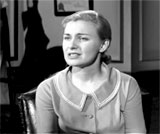
Troubled Eve "White" with Dr. Luther
|

Under Hypnosis, Eve Recalled a Traumatic Childhood
Event
|
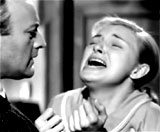
Eve to Dr. Luther: "She made me kiss her!"
|

Flashback: Eve as Young Girl at the Open Casket
of Her Grandmother
|
[Note: The film fictionalized the dramatic revelation
of Eve's traumatic trigger at a young age, causing her personality
fragmentation - it was NOT due to the kissing of her dead grandmother.
Instead, at the age of 2, she experienced or witnessed four troubling
events: (1) a drowned victim in a ditch, (2) a gruesome lumber mill
sawing accident, (3) her own mother's bloody kitchen-accident injury,
and (4) an infant's funeral. Also, the film simplified her malady
- she actually had 22 distinct personalities that often emerged as
threesomes after leaving Georgia, and continued to suffer from split
identities until the mid-1970s.]
- the recollection of her troubled past
helped Eve to purge herself of her two negative 'Eve' selves, integrate
her memories into one person ("Jane"), and cure her of
the psychological disorder; when asked by Dr. Luther: "May I speak
to Mrs. White?" Eve replied: "She's gone"; Eve "Black" had also vanished:
"They're gone, I tell you. Both of them.
They're gone and there's nobody else here but me. I know it. I can
feel it"
- in the film's concluding sequence set in 1955, two
years after her breakthrough, Dr. Luther received a letter from
Jane about how she had formed a new family with Bonnie and a compassionate,
understanding and loving man named Earl (Ken Scott): (voice-over)
("It's the second anniversary of that day in your office, and still no
more Eve White and no more Eve Black. That's why we decided it
was safe at last to have Bonnie with us. And so here we all are,
Earl and Bonnie and me, going home together")
|
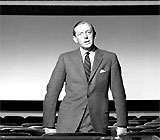
Opening Prologue: Alistair Cooke

In Dr. Luther's Office, With Eve and Ralph White (Joanne Woodward and David Wayne)
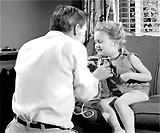
Ralph Saving Daughter Bonnie (Terry Ann Ross) From Being Strangled With
Cord

Disturbed Wife Eve White (Joanne Woodward) - Hearing a Voice

Stunned Reaction to Learning That She Might Have a "Personality Disorder"

Dr. Luther's Description to Ralph of Eve's "Medical Condition"

Eve 'Black's' Seductive Behavior in a Nightclub
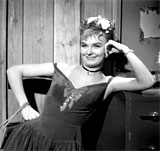
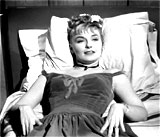
Further Self-Indulgent and Floozy Behavior
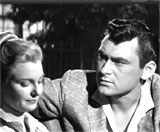
Eve's or "Jane's" New Romantic Interest - Earl (Ken Scott)

"Jane's" Joy About the Disappearance of the Two "Eve's"
In Her Personality: "They're gone...!"
|












